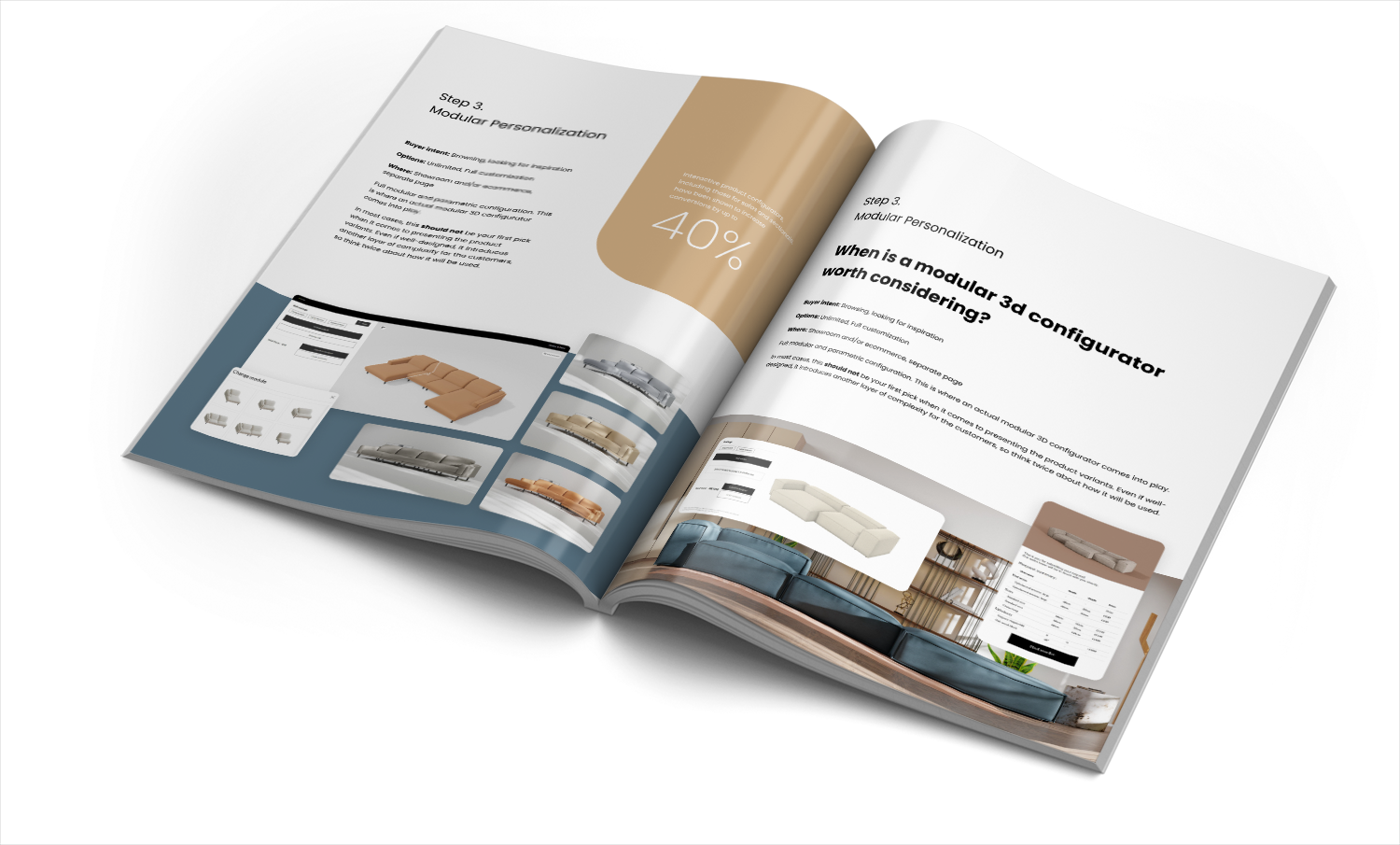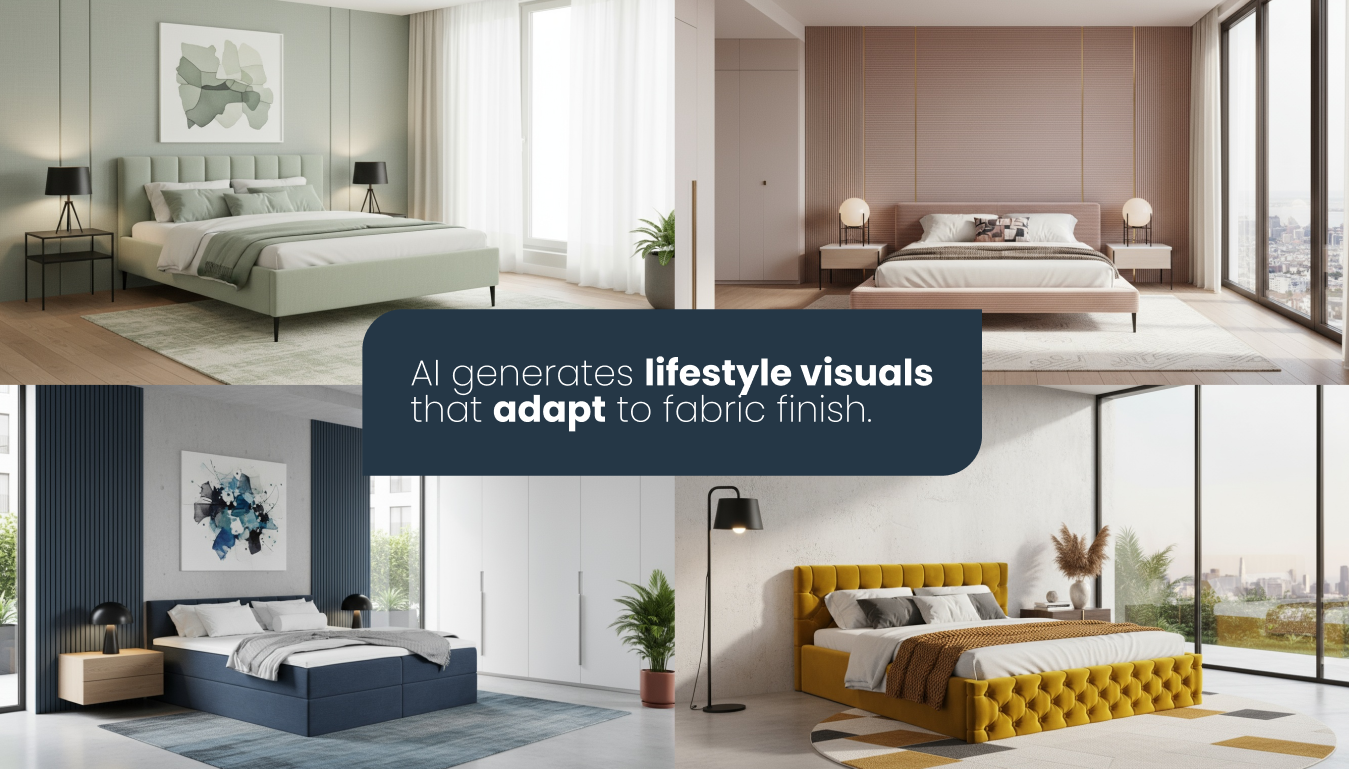The Ultimate 2025 Sofa Configuration Guide
Get your free copy todayy!

When you sell furniture online, you aren’t just selling a sofa, a table, or a lamp. You’re selling a feeling – the story of how that piece fits into someone’s home. That’s where lifestyle product images come in. In B2C furniture sales, visuals are the silent salespeople. A good image can stop a shopper mid-scroll, spark an idea, or even redefine how they picture their living room.
Lifestyle visuals tap into imagination. Studio shots – or silo images – stripped of context, serve clarity but fall short on emotion. The brands that win, the Boca do Lobos of this world, use images to sell a vision before they sell a thing. And in a category where touch, size, and texture matter deeply, that vision is what carries people past hesitation toward commitment.
Most guides will tell you that clean, white-background images are critical for consistency. That’s true. But when selling configurable goods like furniture, they can’t carry the whole conversation. Lifestyle visuals show products in natural surroundings, helping buyers visualize how an armchair fits within a certain aesthetic. They’re not just pictures – they’re emotional shortcuts.
Think of Boca do Lobo’s portfolio. Each room scene tells a story: not just of design, but of personality and aspiration. By placing products in context, they help people connect the dots between brand and identity. That’s something a packshot can’t do. And once that emotional connection is made, trust and desire follow.
Lifestyle imagery also improves consumer perception. Furniture isn’t a commodity; it’s interpretive. The right visual lets someone imagine how a piece breathes life into their own home. In B2C furniture marketing, this emotional groundwork is the difference between browsing and buying.
In the past, product photography was laborious. Each variant meant another physically staged photoshoot. Even traditional product renders could take hours to set up and adjust lighting, fabric textures, or metal finishes. Scalable? Hardly.
But that’s changing. Automated 3D rendering pipelines can now produce consistent, photorealistic visuals of every variant – hundreds, even millions – in a fraction of the time. For brands like Scandic Sofa, which offers extensive customization options, that’s huge. Their focus on bulk rendering ensures no customer has to guess what “sage velvet” or “midnight blue linen” truly looks like. You can see it instantly, in perfect quality.
That kind of detail educates customers. It’s where precision meets persuasion. Once the lifestyle vision has pulled someone in, detailed renders do the heavy lifting of closing the sale. In our own work with visualization automation tools like Automated Product Visuals, we’ve seen this hybrid approach reduce confusion, build confidence, and shorten the buying cycle.
This also ties to the practical distinction between specific steps on the customer’s buyer journey, described in “Furniture and Emotion” article by Marcin Stempniewicz. Lifestyle images are great for inspiration, while thousands of variant visuals are the perfect tool for the customer to make informed decisions on specific product finishes.
Here’s where things get interesting. Some brands treat lifestyle and studio shots as opposites, but they’re really two halves of the same story. During the inspiration phase, lifestyle imagery sells a dream. During the consideration phase, precise, rendered visuals tell the reality of that dream – showing the tangible fabrics, finishes, and proportions.
I’ve seen too many brands stick to one or the other. That’s when things usually go wrong. Without lifestyle context, you lose emotion; without detailed renderings, you lose credibility.
A blended approach gives customers both: aspiration and assurance. Imagine a virtual showroom where the sofa in your favorite ambiance view can instantly change fabrics, sizes, or legs – all rendered perfectly through automated product rendering. Augmented Reality (AR) can then pull that same piece into your own living room, closing the gap between online and real life.
That’s precisely the logic behind Scandic Sofa’s strategy. Their case study shows how combining lifestyle inspiration and automation-driven precision transforms personalization into a guided, effortless experience.
This approach also aligns with our findings on Personalization Strategy — Three Levels of Product Personalization for Furniture. Customers don’t want endless choice – they want guided discovery. Blending aspirational storytelling with educational detail keeps that exploration exciting yet controlled.

Visual technology is moving faster than most people think. We’re entering an era where AI image generation can merge the artistry of lifestyle with the accuracy of product rendering. Imagine uploading a product model, and the AI builds a new lifestyle image around it – adapting lighting, décor, and textures to match your chosen finish.
You don’t need to know how neural networks work to benefit. It’s like having an infinite digital photo studio that understands your brand aesthetic and scales it instantly.
When we combine that with automated rendering pipelines, the result is a living, breathing ecosystem of visuals that always stay current. The product catalog becomes a visual experience hub, not a static library.
So what’s next? AI-driven contextual imagery that evolves with the viewer. Personalized spaces auto-generated to match user taste. Interactive visuals that feel less like browsing and more like imagining your next home.
In the end, it’s simple. Lifestyle product images inspire. Detailed renders inform. Combined, they turn hesitation into confidence and scrolling into purchase.
The winning strategy for furniture brands? Lead with lifestyle storytelling, support with accurate renderings, and enhance the experience with automated, AI-assisted workflows. In 2026 and beyond, guessing how a finish looks is no longer acceptable. Technology has matured. The buyers have too.
The brands that make buying feel real – that’s who people will remember, trust, and buy from again.